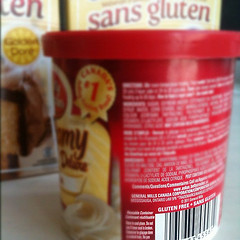
Hidden Ingredients
I remember, after diagnosis with Celiac disease, when I was first learning about going gluten free in those first 7 months in the US as well as in the years after arriving in Luxembourg and now being an expat. I quickly came to the realization that I had to become my own food detective. I did a fair amount of reading to educate myself for the road that was ahead of me. I’m glad I had those 7 months in the US with English so I would have some clue later, when translating labels from many different languages would be a way of life. I was really shocked to find so many ways gluten was incorporated into foods and very often with disguised names. There were so many unusual ways to classify gluten that I had to keep a list in my purse because some of them were just weird and I would have never guessed things like hordeum vulgare (couldn’t it have just said barley!) or some types of modified food starches. These modified starches are often an unspecified food (in the US) so it’s hard to know which food it is that has been modified from so it was a no-go for me.
Those first weeks were really rough. It seemed that no matter how hard I tried, there was almost always a hidden gluten product in the processed foods. I knew imitation crab was a mixed fish product but was surprised to learn it contained gluten. Just as surprising to contain gluten was finding out many ice creams contain this forbidden ingredient, including what I would think would be harmless…vanilla. Yogurt has also become a hiding place for gluten. Processed deli meats, sausages and self-basting poultry were also shocking revelations. Sadly, a popular Luxembourgish and common festival food, Mettwurst has gluten though I’ve found only one that doesn’t (more on this one later).
I have had to learn how restaurants create and prepare the foods they serve such as omelets and scrambled eggs. In order to fluff and add volume to the eggs they add flour. Coated or crispy items are key words for mostly likely rolled around in flour and fried. As if that wasn’t bad enough, to eat anything that is made in the same fry oil is a no-go. That fry oil is almost always shared with a variety of foods which contaminates the oil with gluten and any other number of food allergens thus contaminating food that started off gluten free.
Salads are often a great alternative but the dressing is out of the question including some vinaigrettes. In the EU it’s fairly common to receive your salad with croutons even if it’s not in the description so I make it habit to always say something, just in case. It took a few tries of having a first course of soup to realize, after being mysteriously sick and with some research, that the bouillon contained hidden gluten. I have to admit, my biggest disappointment came when I had to give up most Asian food. So much of it is soy sauce (not gluten free) based making it one of the most impossible foods to enjoy in a restaurant. Tamari (gluten free) is not commonly available in restaurants.
Gluten seems to have become the go-to, possibly cheap filler in processed foods as well as body care and cosmetics products which has made it a minefield. I never would have thought about lipstick or chapstick but have had to learn to read the labels on these too. Thankfully with body care and cosmetic products in Europe, labeling of all chemical and food ingredients is required. The manner in which the names of these ingredients are listed is in accordance with an EU Regulation Directive to ensure that all labeling is consistent. The standard language is Latin and sometime English in order to have the most consistent and recognized terminology within all the countries.
One place I never expected or even thought to consider looking for gluten was in medication and supplements. I was several months into rebuilding my eating scheme and still had not figured that one out. I actually had my doctor mention something when prescribing a medication for me. He explained that pill forms of medications and supplements are notorious for containing gluten and I should be very cautious.
So, I still keep a list in my purse because I tend to get comfortable and sometimes forget. I still do a lot of research to prepare myself at home before setting off to the market. I’m always cautious with new food items and recently had to start rechecking my “tried and true” foods as some ingredients have changed. The food industry is ever changing and thus I must keep up. Like I’ve mentioned before, it’s not like I can use a translation dictionary because most of the terms are not average, everyday words. In Luxembourg I feel pretty safe with labeling as the regulations are fairly strict and everything must be clearly labeled.








recent comments